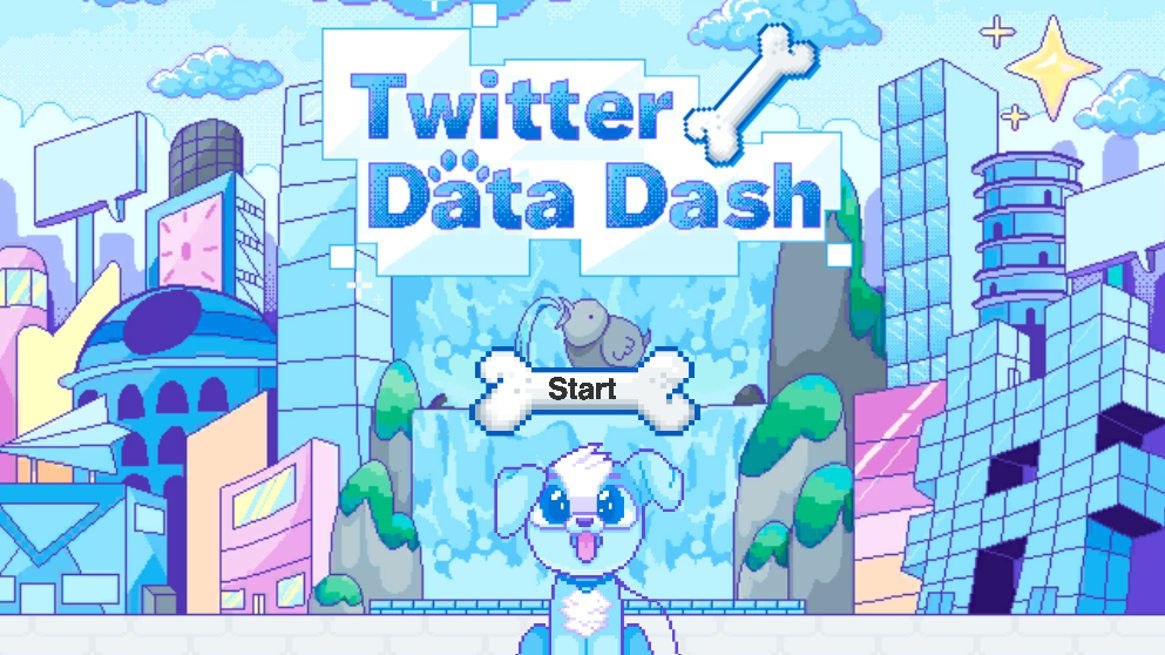Twitter Data Dash is the company's attempt at making their data guidelines more transparent, sort of.
 |
| Screenshot: Twitter |
Twitter unveiled a game designed to help users get a handle on the platform’s privacy policies on Tuesday. It’s both cheery and deeply confusing.
Twitter Data Dash tells the story of you and your dog Data navigating the different obstacles around PrivaCity. The game instructs: “Follow the prompts to keep him safe, and learn how to control your own Twitter experience along the way.” The game is a candy-colored 2D platformer with a simple premise (and a bomb soundtrack). You and your trusty pup need to navigate across four different sprawling locales in PrivaCity, avoiding baddies and collecting bones—a process that the game promises will “help you understand [Twitter’s] privacy policy a little better.”
It didn’t. The game, adorable as it is, is also buggy—both Gizmodo reporters who played got stuck inside different parts of the levels we tried to play. But that’s hardly the worst part. The key problem with Twitter Data Dash is that it doesn’t seem to know what—or to whom—it’s trying to communicate in the first place.
When you boot up the first level, you’re told that Data “wants NO part of the cat ads in your way.” Your goal is to take your pup around the tiny town hunting for hidden bones, while avoiding those ads—personified by bubblegum-pink cats wearing adorable kitty billboards—in the process.
 |
| Screenshot: Shoshana Wodinsky |
If the doggy is supposed to represent our personal data, then is the implication that we can keep advertisers from getting that data just by avoiding them? Are we supposed to scroll past? Not click on them? Use an ad blocker? If Data is our data, what are the bones? It’s a bit rich that Twitter made a game about avoiding faceless advertisers when the platform is actively doing everything it can to make ads tougher to avoid. Most recently, this meant debuting a new product that shoves ads into thread replies—an idea that, as we’ve already reported, manages to piss off Twitter users and Twitter advertisers alike.
The level also ignores some fundamental rules about “data” and “ads,” like the fact that bypassing an ad by say, scrolling past or clicking away doesn’t mean that data doesn’t get collected. Every time you see an ad in your search results, on your timeline, or in your conversations on Twitter, the platform keeps a record of these so-called “impressions” so it can track which eyeballs convert into paying customers, a metric that the platform also tracks. In the world of PrivaCity, the analogue would be that every time Data walks by an ad, the feline advertisers jot down his location and eventually compile a route of his daily walk.
Twitter lets users opt out of targeted ads on the platform; and, to its credit, makes the process pretty easy. But flicking that switch doesn’t eliminate ads on the platform wholesale—they’re still there, and still hoovering data from your glimpses, clicks, app downloads and more, but they’re less specific. And if you cut off that data supply by just... not using Twitter at all, then the company still gets data about you from a clown car of adtech partners, which include notable data brokers like Axciom, Liveramp and Oracle.
If Twitter actually wanted to be accurate with this level, then you wouldn’t be freely running around a city, dodging bad-guys and collecting bones of somewhat questionable origin. Instead, the bad-guys are unavoidable, and they’re not only actively piling on top of your poor Data pup and crushing his tiny lungs, but you, the player, need to live with the knowledge that Data will keep on being smothered long after you exit the game. Fun, right?
After level one, Twitter pivots to the tried-and-true Silicon Valley policy of muddling the word “privacy” until it basically means whatever the company wants it to mean. In the second level, you have to swim through a “sea of DMs” to find the friendly ones. You learn that you can control who sends you a direct message. The third level teaches you how to turn on your precise location. The fourth level teaches you how to protect your tweets from the dreaded Trolls and Reply Guys.
You can—and you should!—flex your ability to control who slides into your DMs and who’s reading your tweets. But does that give you control of your data in any meaningful way? No! Keeping creeps out of your DM’s doesn’t stop your public convos from being mined for profit, and it doesn’t stop your eyeballs from being tracked as you read or report your DM’s. That tracking and targeting is, after all, how Twitter makes money at the end of the day, and something as pesky as people’s qualms over privacy won’t stop them from doing that.
It’s possible that this game is Twitter’s attempt at getting users to engage with the website’s privacy policy. In that regard, it is a step in the right direction, principally because the current presentation of privacy policies could not be worse. It seems more likely that new Twitter users would play a game over reading an impossibly lengthy document.
But after watching our personas bounce from level to level with our lil blue dog in tow, it became clear that this game is less for us—or any Twitter user, really—and more for the company itself. It’s a way to paper over uncomfortable topics like “privacy” and “consent” and “ownership of our personal data” with a lil blue dog, collecting lil bones by hopping across lil stages. Just promise you won’t think about where those bones came from in the first place.
